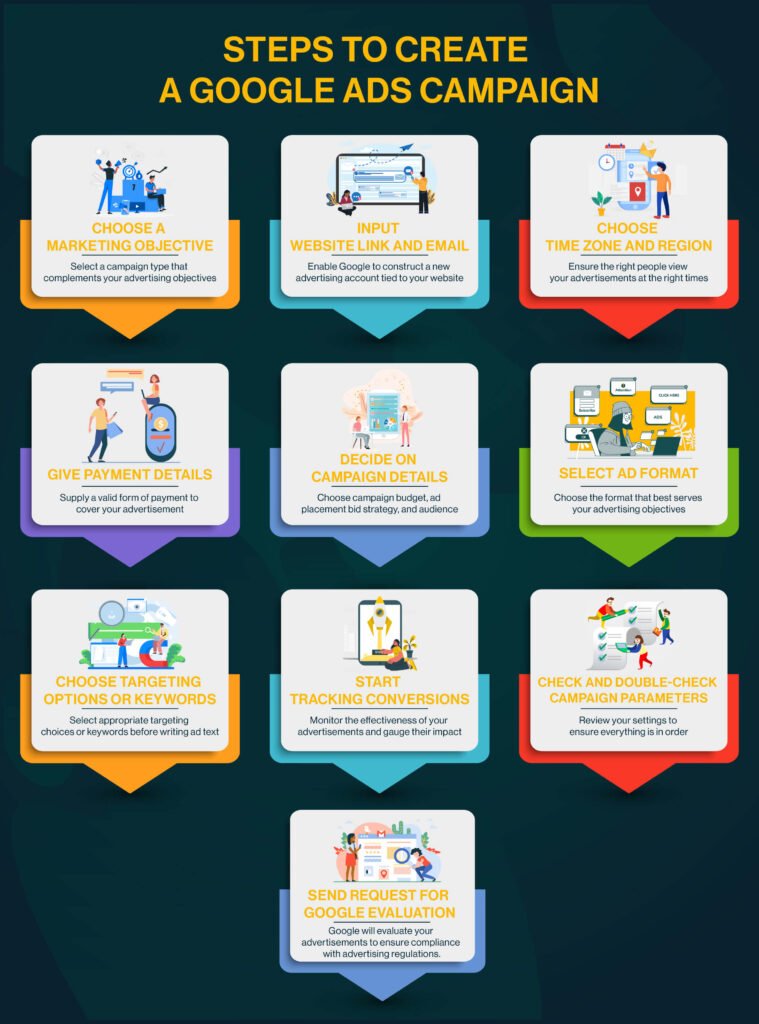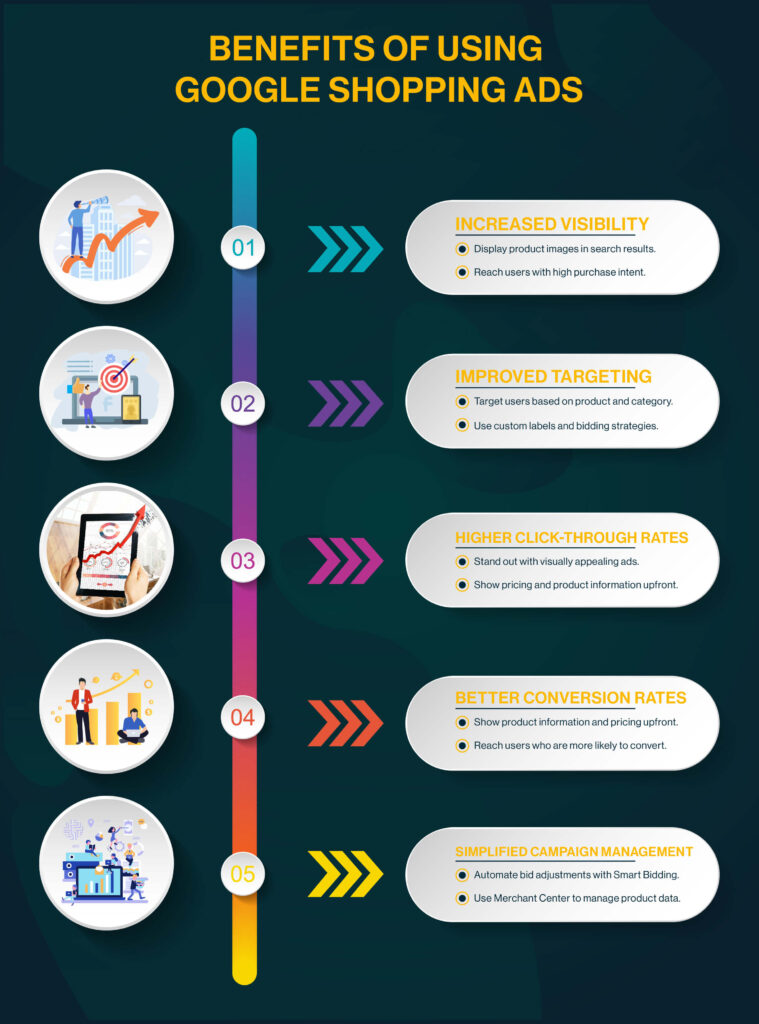Running an eCommerce business is not an easy feat, especially with the fierce competition out there. To keep up with the competition, you need a strong marketing plan. This is where Google Ad for e-commerce comes into play.
With the help of Google AdWords, companies may effectively reach millions of prospective clients at the right time and ideal location. You may make ads using Google AdWords that are targeted at those who are actively looking for goods or services similar to what you offer and increase conversion rates and sales.
Don’t miss out on the potential growth and success that Google Ads can bring to your eCommerce business.
In this blog post, we will explain how to increase your sales with Google Ads for eCommerce. Let’s get started and figure out how to use Google AdWords to raise your eCommerce sales!
Table of Contents
Why Choose Google Ads for eCommerce?
Reach your Target Audience
Google Ads offers a great way to get in front of potential customers with measurable results. You can target customers by focusing on their location, interests, activity, and even income level.
Not only can it help you generate more leads and customers, but you can also make sure your budget is put to its best use by monitoring and adjusting keywords according to their performance.
There are so many different goals you can set with a Google Ads campaign, such as increasing sales, raising brand awareness, generating mobile application downloads, and more.
Cost Efficiency
As an e-commerce business owner, you want to increase your ROI.
With Google Ads, you can reach customers who are actively searching for your products or services, resulting in increased website traffic, higher sales, and improved ROI.
You have full control over how much you spend with Google Ads. By employing the pay-per-click system, you’re only paying for individuals who visit your advertisement, greatly increasing your ROI.
In addition, you may tailor your targeting choices to guarantee that only your intended demographic sees your adverts, increasing the effectiveness of your advertising budget.
Increased Visibility
By investing in Google Ads for E-commerce, you’re already broadening your reach, as Google Ads are visible on the search engine results page and on multiple other channels.
Google Ads offers businesses increased visibility providing your brand with the chance to easily enter different markets, advertise in all types of channels, and reach audiences on all devices.
With Google Ads, you can precisely target who sees your ad, so you don’t have to worry about wasting money on potential customers who don’t fit whom you’re trying to reach.
Increased Traffic
Google AdWords provide an efficient approach for owners of e-commerce businesses to boost website traffic, produce leads, and eventually promote more sales chances.
E-commerce business owners may easily narrow down their target audience by developing Google AdWords campaigns that target certain consumer base groups.
Businesses will be able to filter out irrelevant traffic and capitalize on more qualified leads that are more likely to result in sales by generating highly targeted adverts.
Steps By Step Guide for Google Ads for Ecommerce Websites
Ad account setup and creation
Creating your own Google Ads account is simple if you know how to do it right.
Go to the Google Ads page, and select the “Start Now” option. This will take you to a site where you can make a fresh Google Ads account by pressing here.
- Choose a marketing objective: There are several campaign kinds available in Google Ads, each with unique objectives. For instance, you may decide to design a campaign to increase website traffic, produce leads, or advertise your goods.
- Input the link to your website and your email: This will enable Google to construct a brand-new advertising account that is tied to your website.
- Choose a time zone and region: Doing so will guarantee that the right people view your advertisements at the right times.
- Give payment details: Supply your payment information, such as a checking account or credit card. To cover your advertisement, you must offer a valid form of payment.
- Select a campaign type to start your first advertising campaign: You will be prompted to choose a campaign type that complements your advertising objectives. For instance, you may choose a search campaign if you want to increase website traffic.
- Decide on your campaign’s details: You must choose your campaign budget, your ad placement bid strategy, and the audience you wish to target with your advertising.
- Select the format for your advertisement: Text advertising, picture advertisements, and video ads are just a few of the ad forms that Google advertising provides. You must decide which format would best serve your advertising objectives.
- Select appropriate targeting choices or keywords before writing your ad text: The actual advertisement that will be seen by your target market will be created here. To get people to click on your ad, you must choose the appropriate keywords and write interesting ad language.
- Start tracking conversions: This crucial stage will enable you to monitor the effectiveness of your advertisements and gauge how they are affecting your company. For your website to monitor activities like sales, form submissions, and phone calls, conversion tracking must be set up.
- Check and double-check your campaign parameters: You must check your settings once you’ve set up your campaign to make sure everything is in order. Reviewing your budget, ad wording, targeting possibilities, and other things will be possible.
- Send Google a request to assess your campaign: Google will need to evaluate your advertisements to make sure they adhere to their advertising regulations before they can begin to appear. Normally, this procedure takes a few days.
Once your campaign has been approved, it will begin running, and your Google Ads dashboard will allow you to track its progress. You can monitor how many people are clicking on your advertising, how much you’re paying, and how many sales you’re making.
Product feed setup
A product feed is composed of product information, such as item titles, descriptions, costs, and photos.
Google will employ this information to show your products in promotions on its Search feature, Shopping tab, and other services.
To get started with promoting your online store products on Google Ads, here is how to set up a product feed:
1: Make a spreadsheet with details about your items. The following elements must be present in the file:
- ID: A unique code for each product.
- Title: The product’s name
- Details: Detailed information about the product
- Link: The website address for the product page on yours
- Image: The image URL for the product picture
- Availability: Whether the item is available or not
- Cost: The cost of the item
- Brand: The product’s brand
- Product category: The product’s category or kind
2: Save the document in a CSV, TSV, or XML file type that Google can read.
3: The file should be uploaded to Google Merchant Centre. You may submit your product feed and manage your items using Google Merchant Centre.
4: Google requests that you confirm that you are the owner of the website where your items are offered in order to make sure that your product listings are correct and current. You may upload a verification file to your website, and use Google Analytics or Google Tag Manager to validate it.
5: You may create a Google Ads Shopping campaign after adding your product feed to Google Merchant Centre and validating your website. Create a new Shopping campaign in your Google Ads account and connect it to your Google Merchant Centre profile.
6: For the purpose of organizing your items and focusing on certain audiences in your shopping campaign, build ad groups and product groups.
7: After creating your product groups, you can build advertisements that will be seen by people who do a Google search for your items. Your advertising will include data from your product feed, such as the title, picture, and cost of the item.
8: It’s crucial to constantly review your campaign and make any necessary tweaks to make sure your advertisements are operating effectively and producing a high return on investment. Track the effectiveness of your ads using Google Ads’ reporting tools, and then refine your bids, ad language, and targeting choices to obtain better results.
You may promote your items to a large audience and increase sales for your company by setting up a product feed for Google Ads and developing a Shopping campaign.
Ad Monitoring
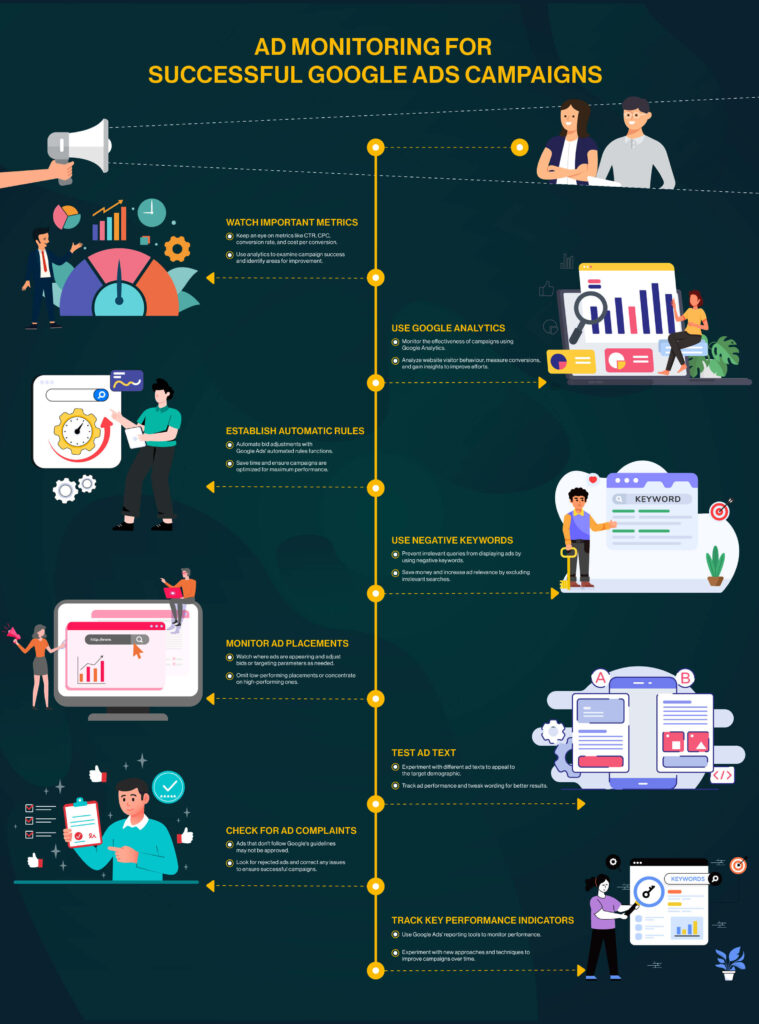
Google ads monitoring is a crucial component of running successful Google Ads campaigns. Here are some essential actions for Google Ads ad monitoring:
- Watch your important metrics: Be mindful of metrics like CTR, CPC, conversion rate, and cost per conversion. These analytics can be used to examine the success of your campaigns and identify room for improvement.
- Employ Google Analytics: You may monitor the effectiveness of your Google Ads campaigns using the potent tool Google Analytics. Use it to keep an eye on website visitor behaviour, measure conversions, and acquire knowledge on how to improve your efforts.
- Establish automatic rules: With the help of Google Ads’ automated rules functions, you may automate certain operations like raising or lowering bids in accordance with predefined standards. You may save time and guarantee that your campaigns are always optimized for optimal performance by setting up automatic rules.
- Use terms that are negative: Negative keywords are those for which you do not want your advertisements to appear. You may save money and increase the relevancy of your advertising by preventing irrelevant queries from displaying your ads by using negative keywords in your campaigns.
- Watch where your ads are appearing: Watch where your advertisements are appearing and change your bids or targeting parameters as necessary. You may choose to omit certain placements or change your bids to concentrate on placements that perform better if your advertisements are appearing on low-performing websites or places.
- Keep an eye on your ad text: To find out what appeals to your target demographic, test out various ad texts. To enhance your results, keep track of how various ad versions are doing and tweak your ad wording as necessary.
- Look for complaints about ads: Ads that don’t adhere to Google’s rigorous advertising guidelines may not be authorised. To ensure that your advertisements continue to run successfully, be sure to look for any ads that have been rejected and correct any problems.
Track your key performance indicators using Google Ads’ reporting tools, and don’t forget to experiment with new approaches and techniques to gradually improve your campaigns.
You may increase qualified visitors to your shop and, eventually, expand your business by taking the time to optimize your Google ads.
Step By Step Guide for Google Ads Optimization for E-Commerce
1. Conducting Keyword Research
Doing extensive keyword research is one of the keys to managing successful Google Adwords campaigns for any eCommerce business. But, how do you approach it? Below is a step-by-step guide to help you get started:
- Use Keyword Planner: Use Google Keyword Planner as a starting point to create a list of relevant keywords for your goods and services.
- Evaluate Competitors: Consider the keywords that your rivals are using, as well as the ad content that they are using. You may learn what works for them and what could work for you from this.
- Use Long-Tail Keywords: Finding long-tail keywords can help you target buyers who are farther along in the purchasing process. For instance, you may target “women’s running shoes for flat feet” rather than “shoes.”
By completing detailed keyword research, you can design focused, relevant advertising that attracts prospective consumers who are more likely to convert.
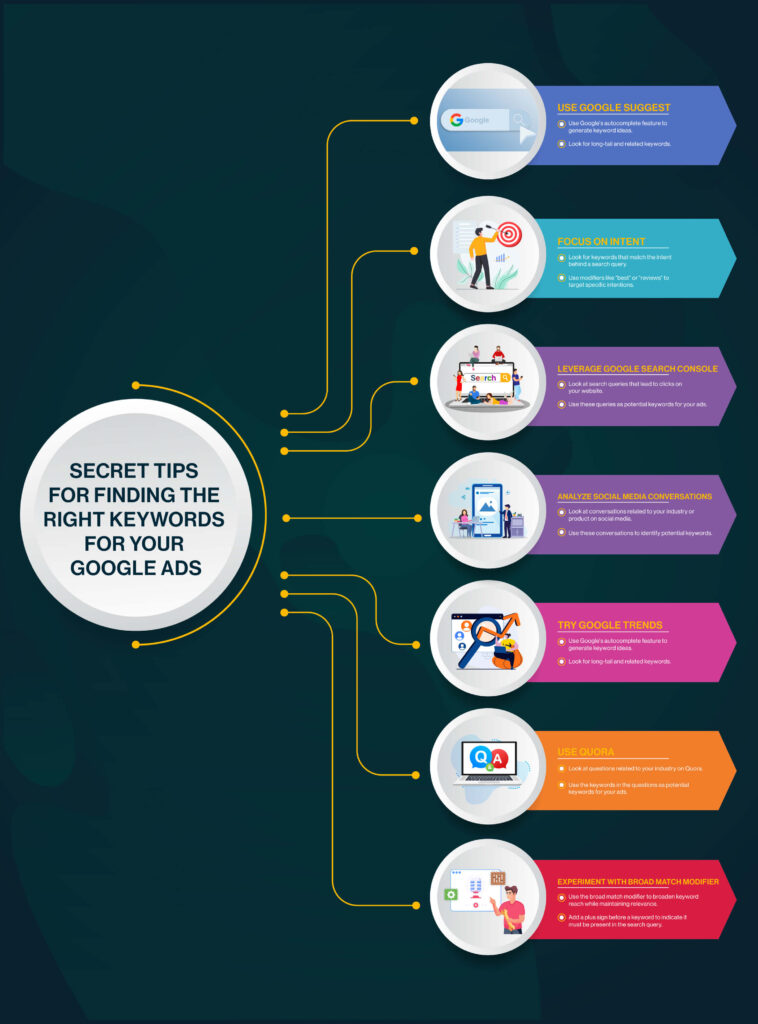
Finding Effective Keywords for Google AdWords Campaigns
You may draw qualified visitors to your eCommerce shop, boost your sales, and raise your income by doing in-depth keyword research and selecting keywords that are consistent with your company objectives and target market.
These are some questions to think about if you want to find the right keywords for your eCommerce business:
- What are your company’s objectives?
- Are you hoping to build your brand’s recognition or increase sales?
- Who is your target audience?
- What are their demographics, inclinations, and interests?
It’s crucial to keep an eye on your campaigns and change your keyword targeting as necessary. This may assist you in maximizing your campaigns’ conversion rates and return on investment.
2. Creating Effective Google Ads Campaigns
You must establish precise objectives and targets, make targeted ad groups, and develop compelling ad text in order to produce successful Google AdWords campaigns. Here is how you do it:
a. Establishing Campaign Goals and Objectives
Set SMART objectives and targets for your Google AdWords campaigns to begin with. Specific, Measurable, Attainable, Relevant, and Time-bound is the acronym for SMART. For instance, you could want to grow sales by 20% over the next three months.
b. Developing Ad Groups and Producing Powerful Ad Copy
After that, create ad groups for your ads depending on your keyword strategy and corporate objectives. Here are the simple steps you need to follow:
- Choose your keywords: Based on your goals and research, choose the terms you wish to target.
- Group your keywords: Build ad groups by grouping your keywords according to themes or subjects. You may make ad groups for running shoes, formal shoes, and casual shoes, for instance, if you sell shoes.
- Make ads appealing: Create compelling advertising content that includes a call to action that is apparent to your target demographic. To boost relevancy, emphasize your unique selling proposition and use keywords into your ad language.
- High-conversion landing pages: Moreover, make sure your landing pages have a clear call-to-action and are relevant to your advertisement. This might raise your quality score and raise your ad relevance score, which could result in cheaper prices and better ad placement.
c. Designing Eye-Catching Ad Images
Here are some tips to create eye-catching ad images that grab your potential customers’ attention and showcase your products:
- Use high-quality images: Choose images that are high-resolution and showcase your product in a visually appealing way.
- Incorporate branding: Include your brand logo or colors to increase brand recognition.
- Use contrasting colors: Choose colors that contrast well to make your ads stand out.
- Highlight your unique selling proposition: Include your unique selling proposition (USP) in your ad image to differentiate your product from competitors.
These strategies can help you engage your target audience and persuade them to take action, resulting in a more successful eCommerce business.
3. Optimizing Google Ads for Maximum Sales
a. Monitoring and analyzing campaign performance
Monitoring and assessing the effectiveness of your Google Adwords campaign is essential to ensuring that your advertising expenditure yields the expected results. These are some essential parameters to monitor:
- Click-through rate (CTR): The CTR is the proportion of clicks your advertisement obtains in relation to the number of times it was shown. A high CTR implies that your advertisement is engaging and relevant to its intended audience.
- Conversion rate: The conversion rate is the proportion of clicks that result in the intended activity, such as a sale or a lead. This metric indicates how well your ad is driving conversions and revenue.
- Cost per conversion: The cost per conversion shows how much you are spending on average for each desired action like app install, clicks etc. This metric is important to keep under control to ensure a positive return on investment.
To effectively monitor and analyze your campaign performance:
- Use the Google Ads dashboard to track your key metrics and identify trends over time.
- Segment your data by different categories, such as location or device, to identify areas for improvement.
- Use A/B testing to test different ad copy, targeting, and bidding strategies to optimize your performance.
b. Adjusting bids and budgets for maximum ROI
Optimizing your return on investment (ROI) with Google AdWords requires adjusting your bids and budgets. Here are some suggestions for efficiently adjusting your bids and budgets:
- Define business objectives and KPIs: Establish the success criteria for your campaign and establish KPIs that fit with your business objectives.
- Regularly monitor your performance: Monitor your critical metrics, such as conversion rate and cost per conversion, in order to find opportunities for development.
- Change your budgets and bids according to performance: Raise bids for keywords that are generating conversions and lower prices for underperforming keywords.
- Use bid strategies: Consider using automated bid strategies, such as Target CPA or Target ROAS, to optimize your bids based on your desired cost per conversion or return on ad spend.
By monitoring your campaign performance and adjusting your bids and budgets accordingly, you can maximize your ROI and achieve your business goals in Google Ads.
c. Split testing ad copy and images
A/B testing, or split testing, is an effective method for refining your Google AdWords campaigns. You may enhance your click-through rate, conversion rate, and other critical metrics by identifying the most successful ad wording and picture variants via testing. Here are some tips for conducting split testing experiments:
- Test one variable at a time: To accurately measure the impact of your tests, it’s important to only change one variable at a time, such as ad copy or image.
- Test multiple variations: Test at least two variations of your ad copy or image to determine which performs best.
- Set up your experiment correctly: Use Google Ads’ built-in experiment feature to set up your split testing experiment correctly and ensure that your results are statistically significant.
- Monitor and adjust: Continuously monitor your experiment and adjust your ads based on the results to optimize your performance.
d. Optimizing landing pages for maximum conversions
Optimization of landing pages is crucial to the success of a Google AdWords campaign. Here are some strategies for maximizing conversions on your landing pages:
- Use A/B testing
A/B testing allows you to test several variants of your landing page to determine the most effective version. Improve your conversion rate by experimenting with various headlines, graphics, text, and calls to action.
- Use heatmap analysis
Tools for heatmap analysis allow you to monitor how people interact with your landing page. Use this information to find regions of your website that are producing friction and make the necessary adjustments.
- Keep it simple
Your landing page should be straightforward, brief, and centered on the intended action. Minimize distractions and clutter that might cause people to leave your website.
- Use social evidence
Social proof, such as customer testimonials or reviews, may be an effective means of establishing credibility and encouraging conversions.
- Mobile friendly
It is essential to ensure that your landing page is optimized for mobile visitors, since the bulk of internet traffic is currently generated by mobile devices. Employ responsive design and guarantee that your website loads swiftly on mobile devices.
With these strategies you can enhance the overall performance of your Google AdWords campaigns and optimize your landing pages for maximum conversions.
4. Maximizing Conversions with Google Shopping Ads
Understanding Google Shopping Ads and Its Benefits
Google Shopping Ads are a highly effective advertising format for e-commerce businesses that want to promote their products to users who are actively searching for them on Google’s search engine results page (SERP).
Here are some benefits of using Google Shopping Ads:
Optimizing Google Shopping Ads
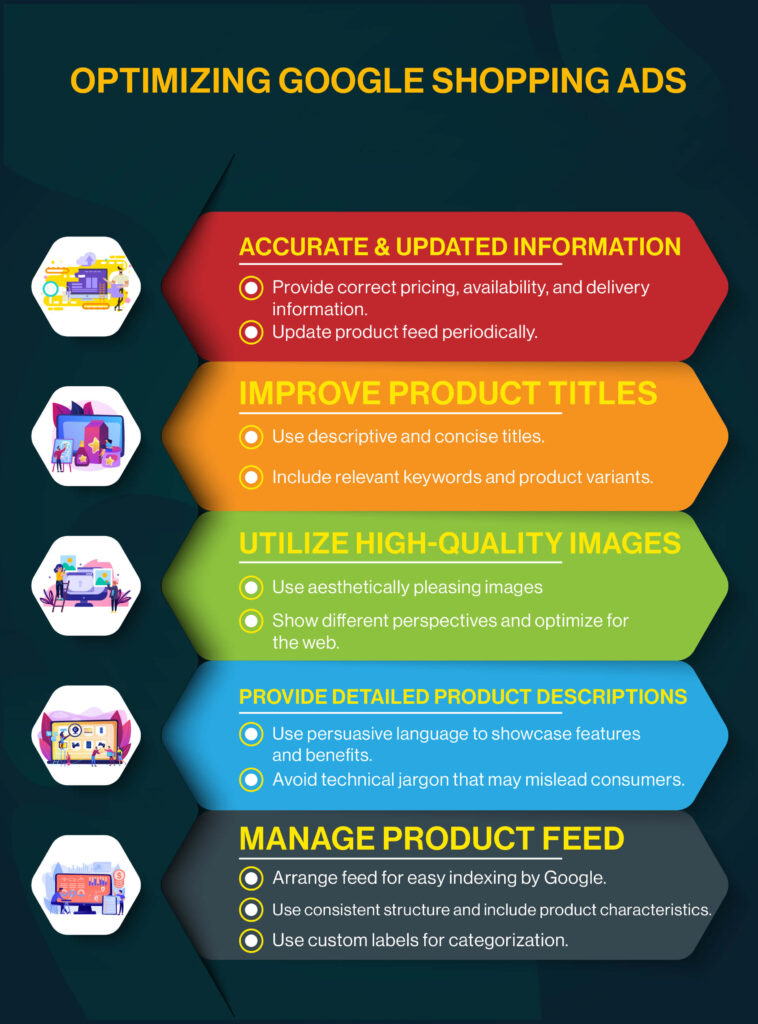
Many people are confused and wonder “How do I increase my product visibility on Google Ads?”. Here is a detailed guide on how you can boost the visibility of your feed!
The core of any Google Shopping Advertising campaign is your product feed. To guarantee that your items are presented precisely and visually appealingly on the search engine results page, it is essential to develop an effective product feed.
The following procedures must be taken to produce a successful product feed:
Give Accurate and Updated Information
- Your product feed should provide correct and up-to-date product information. This covers pricing, availability, and delivery information.
- Ensure that you periodically update your product feed to reflect any changes in your inventory or price.
Improve Your Product Titles
- One of the most crucial components of your product feed is the names of your products. They should be descriptive, succinct, and include pertinent keywords.
- Avoid using general or ambiguous terminology, and mention any product variants, such as color or size. This will guarantee that your items are visible to consumers looking for certain products or features.
Utilize High-Quality Images
- Your product photographs should be of good quality, aesthetically pleasing, and comply with Google’s specifications.
- Use photographs that correctly depict the product and give many perspectives.
- Ensure that your photographs are web-optimized and load swiftly. Crop, resize, and modify the color of your photographs with image editing software.
Provide Detailed Product Descriptions
- Users should be able to find all the information they need to make a purchase in your product descriptions.
- Employ persuasive language to showcase the features and advantages of your items.
- Avoid employing jargon or technical phrases that might mislead consumers.
Manage Your Product Feed
- Arrange your product feed so that Google can easily crawl and index your items.
- Adopt a consistent structure for your product names and descriptions, and include all required product characteristics.
- You may also use custom labels to categorize your items by category, price range, or other qualities.
How to optimize product titles, and descriptions and test Google Shopping Ads?
Here are some specific recommendations for improving your product names, descriptions, and images:
Use Relevant Keywords
- Including relevant keywords in your product names and descriptions is one of the most crucial components of improving your product feed.
- This will enhance the relevancy of your advertisements and raise the probability that they will be shown to people looking for such phrases.
- Identify the most relevant and high-volume keywords for your items using keyword research tools.
Create Captivating Descriptions
- Your product descriptions should be appealing and detailed.
- They should emphasize the distinctive qualities and advantages of your items and urge consumers to visit your website.
- Make sure your descriptions are well-written, error-free, and simple to read.
Test and improve
- To get the most out of your Google Shopping Advertising, it’s essential to continuously test and optimize your product names, descriptions, and photos.
- Experiment with various versions of your titles and descriptions, try various photos and image sizes, and monitor your key metrics to find places for improvement.
5. Monitoring and adjusting bids for maximum ROI
Here are some comprehensive procedures to monitor and change your bids:
Use Bid Modifiers
- Bid modifiers enable you to modify your bids depending on parameters such as device, location, and time of day.
- If you see that your advertising performs better on mobile devices, for instance, you might boost your bids for mobile devices to optimize their performance.
- This will assist you in optimizing your bids for optimum performance and ROI.
Employ Bid Strategies
- Bid strategies, such as Target ROAS and Improved CPC, may help you automatically modify your bids depending on your intended return on ad spend (ROAS) or conversion rate.
- These tactics employ machine learning to dynamically alter your offers depending on the likelihood that a click will result in a convert.
- This allows you to optimize your bids for optimum performance and ROI without manually adjusting them.
Monitor Your Campaigns Constantly
- Monitoring your important metrics, such as cost per click and conversion rate, is essential for identifying areas for improvement and modifying bids and budgets appropriately.
- Utilize Google AdWords’ reporting tools to periodically analyze your campaigns and uncover any underperforming keywords or goods.
- You may then alter your bids or pause these things to enhance the success of your campaign.
Establish Bid Adjustments for High-Performing Products
- Find your best-performing items by monitoring your key KPIs, and change your bids appropriately.
- Bids for items with high conversion rates should be increased, while bids for products with poor conversion rates should be decreased.
- This will assist you in optimizing your bids for optimum performance and ROI.
Keep an eye on your rivals
- Observe the bids of your opponents and alter your own offers appropriately.
- Use Google AdWords’ Auction Insights report to track your competitors and uncover chances to boost bids for high-performing items or reduce bids for low-performing products.
Google Shopping Ads vs. Standard Text Ads for Ecommerce
Feature | Google Shopping Ads | Standard Text Ads |
Ad Format | Visual, product images, titles, prices, store name | Text-based, headline, description, display URL |
Ad Placement | Top of SERP | Top or bottom of SERP |
Displayed Information | Comprehensive overview of product, multiple images | Limited to headline, description, display URL |
Targeting | Based on Product Feed, Keywords, Location | Based on Keywords, Location, Demographics |
Click-Through Rate (CTR) | Higher, more visually appealing | Lower, text-based |
Conversion Rate | Higher, better display of product features and benefits | Lower, less visually appealing |
Cost Per Click (CPC) | Lower, more competitive pricing | Higher, more expensive |
ROI | Higher, better conversion rates and lower CPC | Lower, higher CPC and lower conversion rates |
Management | Feed Optimization, Bid Adjustments, Product Grouping | Keyword Research, Ad Copy Optimization, Bid Adjustments |
Reporting and CRO
Conversion Rate Optimisation (CRO) and reporting are two critical components of operating productive Google Ads campaigns. Let’s look at how you can effectively use these two techniques:
Reporting
- Track your important performance indicators, including click-through rate, cost per click, and conversion rate, using Google Ads reporting tools. To concentrate on the indicators that are most important to your organisation, you may develop bespoke reports.
- Examine your data to look for patterns and trends. Look for areas in which your efforts are succeeding and those that need development.
- Based on your reporting, make choices that are data-driven. Make changes to your campaigns, such as changing bids, ad wording, or targeting settings, using the information you get from your reports.
- To be sure that your campaigns are accomplishing your objectives, frequently check your reporting. To ensure that your campaigns function at their best, make necessary modifications if you come across any problems or opportunities.
Optimisation of conversion rates (CRO)
Determine your conversion objectives: Whether you want to boost sign-ups, drive sales, or create leads, it’s critical to establish your conversion objectives upfront so that you can tailor your efforts to achieve them.
A/B Testing: To make your landing pages and ad text more effective, use A/B testing. To determine which versions of your landing pages and ad text perform the best, test several iterations of them.
Simple Landing Pages: Your landing pages should be made simpler to boost conversions. Ensure that the calls to action on your landing pages are obvious and conspicuous.
Use Retargeting: Retargeting is a technique you may use to contact website visitors. Retargeting is a potent strategy for re-engaging people who have previously shown interest in your goods or services.
Track Coversions: Keep an eye on your conversion rates and make any marketing adjustments. Make data-driven choices about your campaigns using the information you learn from your reports, such as modifying your bidding strategy or improving your ad targeting.
To guarantee that your campaigns are continually operating at their peak effectiveness, check them often, experiment with alternative approaches, and make necessary modifications.
How do you increase the conversion rate in e-commerce?
E-commerce businesses may utilize the following methods to raise their conversion rates:
- Improve website design: A well-designed website with a user-friendly interface and straightforward navigation may assist to enhance the overall user experience and raise conversion rates.
- Provide free shipment: As many consumers find shipping costs to be a significant deterrent, providing free delivery will help encourage purchases.
- Provide social proof: Adding user reviews, ratings, and endorsements on the website may aid in establishing credibility and trust with visitors.
- Use retargeting advertisements: Retargeting ads may help you connect with website visitors who have previously visited but did not convert by giving them a second opportunity.
- Streamline the checkout process: Cart abandonment may be reduced and conversion rates can be raised by streamlining the checkout process and minimizing the number of stages.
- Provide discounts, promotions, and other incentives. These offers may assist to entice consumers to make a purchase and boost conversion rates.
By putting these tips into practice, ecommerce businesses may enhance conversion rates, boost consumer confidence and trust, and optimize their websites and marketing campaigns.
Conclusion
Google Ads can be a game-changer for eCommerce businesses looking to drive traffic and boost sales.
By using the proper tactics, such as building effective product feeds, optimizing ad wording and pictures, monitoring and modifying bids, and developing a comprehensive marketing plan, eCommerce firms may maximize their return on investment (ROI) with Google Adwords campaigns.
However, running effective Google Ads campaigns can be a complex and time-consuming process. For eCommerce firms trying to improve their Google Adwords campaigns and maximize their ROI, employing an expert agency might be a game-changer.
A professional Google ads management agency can assist you in developing and implementing a thorough plan that considers your company objectives, target audience, and competitors. Your eCommerce firm may fly to new heights and reach unprecedented success with the correct approach and knowledge.
Need help with Google Ads? Contact RankON Technologies today for best Google ads management services in India. We offer affordable PPC Packages and provide top quality support.
FAQs on Google Ads for Ecommerce
Certainly, Google Ads can work wonders for online businesses. With the help of Google Ads, eCommerce businesses can target their advertisements to the right people.
eCommerce businesses can use Google Ads to display their ads to consumers actively looking for their goods or services by using keywords and niche audience targeting. Google Ads also offers a variety of ad types, such as text, display, and shopping ads, which can be customized to gain higher conversions and return on investment.
Shopping ads particularly may be advantageous for eCommerce businesses since they enable consumers to explore and compare goods by directly displaying product photos, pricing, and other information in the search results.
Managing profitableGoogle Ads campaigns isn’t easy and it needs proficiency in data analysis, ad composition, bid administration, and keyword research. To make sure they get the most out of their advertising budget, online businesses should think about collaborating with knowledgeable Google Ads specialists or agencies.
Online businesses can use Google Ads, Facebook Ads, and Instagram Ads to effectively achieve their advertising objectives, target their market, and stay within their budget. A market analysis shows that Google Ads is particularly useful for increasing online exposure, as it is responsible for 88% of all search ad clicks on Google, with search ads, display ads, and shopping ads available.
Businesses may develop highly targeted ads with Facebook Ads based on the demographics, interests, and behaviors of users. On the other hand, Instagram Ads provide companies the opportunity to display their goods in eye-catching forms including picture, video, and carousel ads.
Amazon Advertising, which is especially helpful for companies selling items on Amazon, and LinkedIn Ads, which is perfect for B2B businesses targeting individuals in certain sectors, are other ad platforms that eCommerce businesses may explore.
The ideal advertising platform for eCommerce businesses ultimately relies on their unique objectives, spending capacity, and target market. To choose the platform that is perfect for your company, it is crucial to perform extensive study and testing.
No, SEO is not directly impacted by Google Ads. A website’s traffic may be increased using both SEO and Google Ads. The process of optimizing a website to show up higher in organic search engine results is referred to as SEO.
Although Google Ads does not directly affect SEO, it may indirectly help SEO by increasing website traffic, which can then raise brand recognition, backlinks, and social media shares, all of which can eventually boost organic search ranks.
The conversion rate of your adverts may be influenced by a variety of variables, thus there is no clear answer to this question. These factors include
- The appeal and quality of your landing page and ad text
- Who your target audience is and what their goals are
- The cost and level of competition of your commodity or service
- Your market’s seasonality and demand
The average conversion rate for Google AdWords across all sectors is 4.4%, according to a WordStream analysis. This indicates that you may anticipate four sales for every 100 hits on your adverts.
But, depending on your sector and expertise, this figure might change dramatically. For instance, the survey discovered that the conversion rate for online shopping was 2.81% whereas it was 6.03% for home services.



